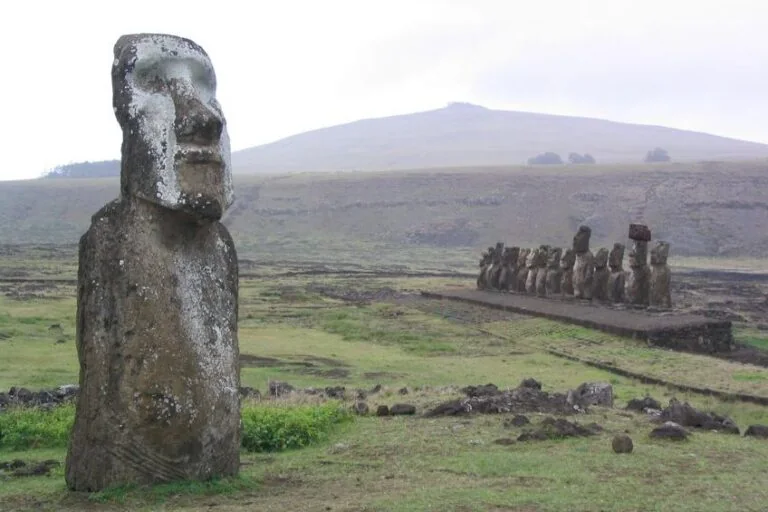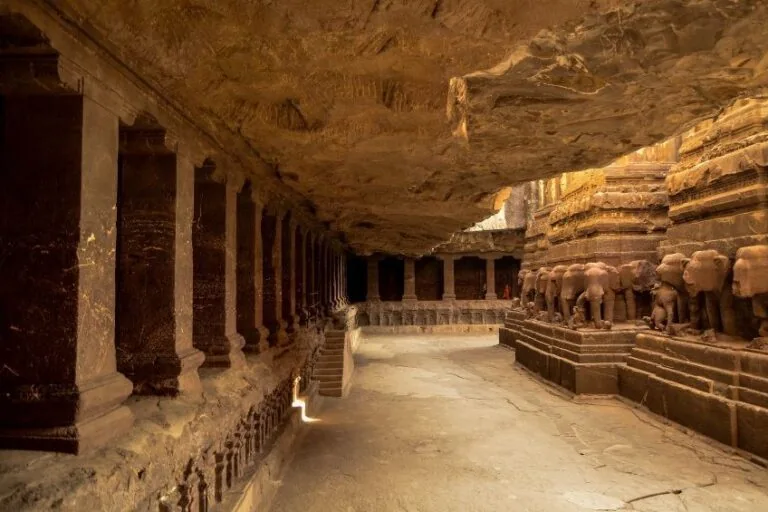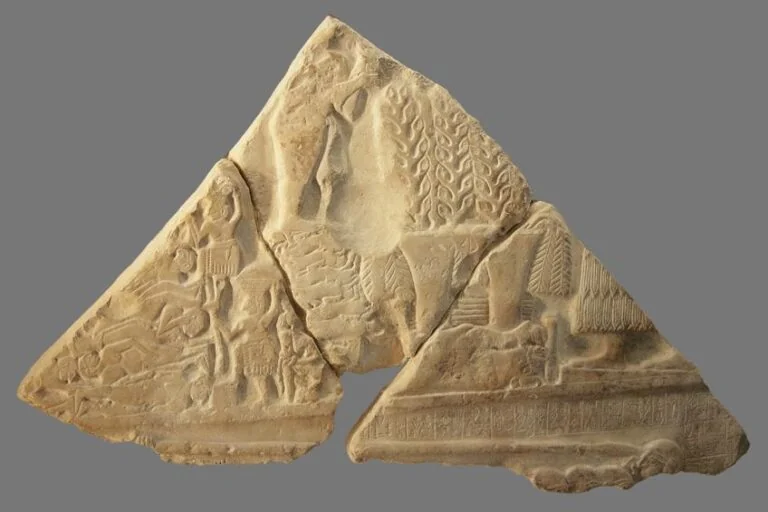Ziggurat of Ur – The History of the Ziggurat Buildings
Iraq is commonly known as the cradle of civilization, which comes as no surprise considering how many of the oldest artifacts, structures, and ancient civilizations can be found there. One of the most popular monuments ever discovered in this part of the world is the Ziggurat of Ur. If you’ve never heard of it, we’ve prepared a short rundown of exactly what the Ziggurat of Ur is, why it was built, what its purpose was, its structure, and why it is of the utmost historical importance not only to the people of Iraq, but to the rest of the world too.
Contents
What Is the Ziggurat of Ur?
| Architect | Ancient Sumerian people |
| Materials Used | Clay bricks joined using bitumen |
| Location | Nasiriyah, Iraq |
| Size (m) | 64 x 45 x 30 |
| Function | Ritualistic and religious applications |
| Discovery | By Sir. Richard Woolley in 1850 |
What is a Ziggurat? Essentially a ziggurat is an ancient structure reminiscent of a pyramid. These structures differ from pyramids, in that instead of a smooth four-sided exterior that tapers off slowly toward the summit, the Ziggurat has a stepped exterior. The structure still tapers upward, but instead of reaching a point they usually have a flat surface at the very top. The ziggurat has used space for ceremonial and/or ritualistic practices in Near Ancient Eastern civilizations. Like ancient Egyptian pyramids, these structures are four-sided and (as we mentioned previously) four-sided that tapped upward in a stepped manner. The four sides rising towards the sky were meant to represent the structure reaching up to the heavens.
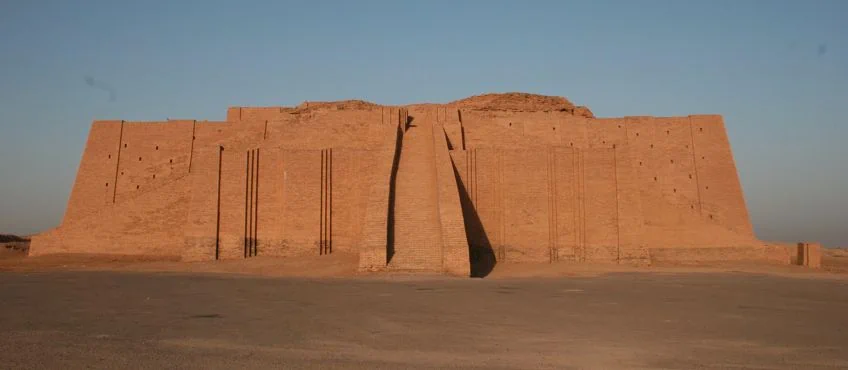 Ziggurat of Ur (2100 BCE); Tla2006 at English Wikipedia, Public domain, via Wikimedia Commons
Ziggurat of Ur (2100 BCE); Tla2006 at English Wikipedia, Public domain, via Wikimedia Commons
These structures can be found all over what used to be ancient Mesopotamia which is now modern-day Iraq. Why are they found so frequently you ask? These structures were used to both facilitate and oversee a number of religious rituals that were practiced by the people of the time. Despite their age and degradation over time, they stand as an incredible testament to the willpower, ingenuity, and creativity of these ancient people. Arguably the most popular Sumerian ziggurat is known as the Ziggurat of Ur, a particularly well-preserved and large ziggurat that was discovered buried in the 1900s and was subsequently uncovered by Sir Leonard Woolley in the year 1920. He would later join forces with the University of Pennsylvania Museum to fully uncover the structure and reveal it to the world.
Sir. Woolley discovered what appeared to be a large, four-sided pyramid structure that had been partially covered in the earth over the centuries. The structure was quite large, measuring a staggering 64 x 46 meters in total surface area at its base, in addition to what appeared to be three terraces located at different levels of the structure as one ascended.
Design of the Ziggurat of Ur
The Sumerian ziggurat had these staircases to provide access to its iconic three-level design. The first set of stairs provided access to the gate of the ziggurat, which is essentially two pillars located on each side of you once the landing has been reached. The second set of stairs provided access to the second level, which essentially existed to support the final level. The final set of stairs provided access to the final level of the ziggurat, which is an exposed platform located at the very top. Unlike the pyramids that were primarily used as tombs for figures of prominence in ancient Egyptian society, the ziggurat is a solid structure with no interior. What were ziggurats made of, you ask? The Ziggurat of Ur (and others like it) are constructed from mud bricks that have been joined together using a naturally occurring tar known as bitumen.
Each of the aforementioned bricks measured 29 x 29 x 7 cm and weighed a staggering 14 Kilograms each, making the construction of this monument even more impressive considering the technology that was available at the time. If you think those numbers are impressive, consider that the base of the structure that supports all three levels took a whopping 720,000 clay bricks to construct! The amount of manpower needed to not only construct such a monument, not to mention the labor involved in creating the bricks in the desolate environment would have been impressive even by modern standards. Considering that structures like these were built without the aid of power tools, it would have taken a colossal amount of time to construct just one ziggurat.
History of the Ziggurat of Ur
Knowing the scale of one of these structures tends to raise a lot of questions in the mind of one learning about them for the first time. One of the most commonly asked questions is who built the ziggurat. While we might not know who laid the bricks we do know who commissioned its construction. According to ancient records, the Ziggurat of Ur was commissioned for construction by King Ur-Nammu who belonged to the Third Dynasty of Ur around 2100 BCE. The king, and by extension his dynasty, built the ziggurat in honor of the moon Goddess Nanna who was the patron saint of the city-state over which they ruled.
At the time of its construction, the Ziggurat of Ur would have been the largest structure in the city-state with no other building in the vicinity of the structure even coming close. Due to its size, the structure would have been seen for miles around, attracting both those who followed the faith and travelers in the region alike.
As it was the focal point not only for the city-state in which it sat, but the Ziggurat of Ur would also have been a sort of assembly point for major events such as the distribution of food rations, and a meeting point where surpluses of produce and livestock would have been brought. Due to its grandiosity, what it represented, and its location, it is said that to travel to the Ziggurat of Ur in these times was to become nourished both in a physical and spiritual sense. The structure proved to be quite the display of power as well. How much of a display of power do you ask? Well, the ruler at the time named King Shulgi declared himself a God, and united many of the city-states of ancient Mesopotamia under his rule. This led to the creation of many of these structures throughout the years, which is why we have so many of them today.
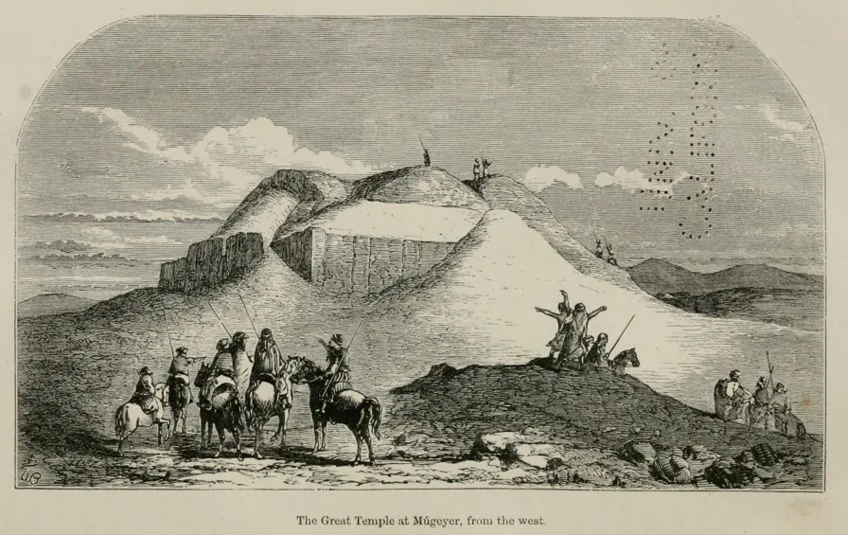 Discovery of the Ziggurat of Ur (The Great Temple at Mugeyer from the west) (1857) by William Loftus; William Loftus, Public domain, via Wikimedia Commons
Discovery of the Ziggurat of Ur (The Great Temple at Mugeyer from the west) (1857) by William Loftus; William Loftus, Public domain, via Wikimedia Commons
The city of Ur, as you can probably imagine by the scale of this structure, was quite a wealthy one, boasting a population of 60,000 people at the peak of its ancient Sumerian society. The city has been characterized as one of the very first cosmopolitan cities in the world, which is part of the reason it is of such historical and cultural interest around the world. In addition to its large population, advanced feats of civil engineering, staggering wealth, and prominence as a landmark in the region, the city of Ur also has biblical significance. How? The city of Ur is said to have been the hometown of the biblical prophet Abraham, which brings into question why it still holds relatively little draw as a tourist destination or site of pilgrimage.
The Nanna Temple
The Nanna temple was located at the very top of the Ziggurat structure and was used for a number of religious and ritualistic ceremonies. Unfortunately, due to exposure to the elements and the substituent degradation over time the temple no longer exists, instead leaving behind an empty platform at the very time of the structure. Why is it called the temple of Nanna? Nanna was the patron saint of the city-state of Ur. Each city-state was believed to be the home of the deity that protected and enriched their inhabitants who would give offerings and praise to the deity. Nanna was the moon goddess who oversaw the city of Ur, and the Ziggurat at its center was dedicated to her specifically.
The Cult of Nanna is what the religious group that worshipped at this temple was known as. Their practices were related to the cycles of nature and the herding of livestock. It is believed that this cult developed very early on in the lower course of the Euphrates, which is where the center of Ur would have been located.
The ziggurat was not only a place where those who wished to grant offerings to the moon goddess could congregate but it was also seen as the “home on earth” of the goddess. As a result, the location was considered to be sacred and was generally well looked after compared to conventional, generic structures inside the city-state. Like the entrance to the city of Babylon that is also found in the region, archaeologists found blue bricks in the ruins of the temple that hint at what the temple could have looked like in its prime. Even though the utmost portion of the temple has been eroded over time the lower half survived relatively intact, revealing interesting details about the structure’s design.
 Computer reconstruction of the Zugurat of Ur-Nammu Showing the Nanna Temple based on a 1939 drawing by Leonard Woolley; user:wikiwikiyarou, Public domain, via Wikimedia Commons
Computer reconstruction of the Zugurat of Ur-Nammu Showing the Nanna Temple based on a 1939 drawing by Leonard Woolley; user:wikiwikiyarou, Public domain, via Wikimedia Commons
The design of the temple included rudimentary climate control systems designed to keep the core of the structure cool during the harsh summer months. Why? Even though the core of the ziggurat buildings is solid, the bricks that form its interior are made of unbaked mud, a material that tends to unravel once a certain temperature has been reached. As a means to counteract this heating effect, holes were included in the walls of the ziggurat’s foundation to allow cool air to pass through/over the brick and keep them cool. Additionally, in an effort to stave off degradation due to excessive exposure to condensation and rain in the wet season, drainage systems were included in the design as well.
Restoration Attempts
The region has had many leaders over time and some of them have attempted to restore the structure to its former glory. The first (alleged) attempt was made by Nabodinus, the very last Neo-Babylonian king who sought to restore the ziggurat buildings to their former glory, who apparently restored the first and second terrace of the Ziggurat of Ur sometime in the 6th Century BCE.
The latter is up for debate due to a lack of evidence. However, there is a confirmed case of restoration that took place back in the 1980s by the then leader at the time Saddam Husain. Husain restored the façade of the base of the structure in addition to the three enormous terraces leading to each level of the structure.
Due to the political situation in the region, the restorations that were done under the rule of Husain were undone due to conflict in the region. Bombardments by coalition forces have damaged the structure in recent years, a situation that the former president sought to avoid by parking two of his jets next to the structure, an effort which ultimately proved fruitless.
The Abandonment of the Ziggurat of Ur
Now you might be asking yourself why anyone would let a structure like this fall to ruin. Well, just as times change so do circumstances. Put simply, the surrounding environment of the region was fast becoming uninhabitable. Due to the Euphrates River changing its course over time the city, its livestock, and agriculture dried up, forcing the people to move. As a result, this led to Ur, along with many other cities in the region becoming abandoned. This mass immigration left the temple and the city-states associated with them to be devoured by the elements of the region, which is partially why many of them are nothing but ancient ruins today. These cities were eventually buried in sand until their rediscovery in later years.
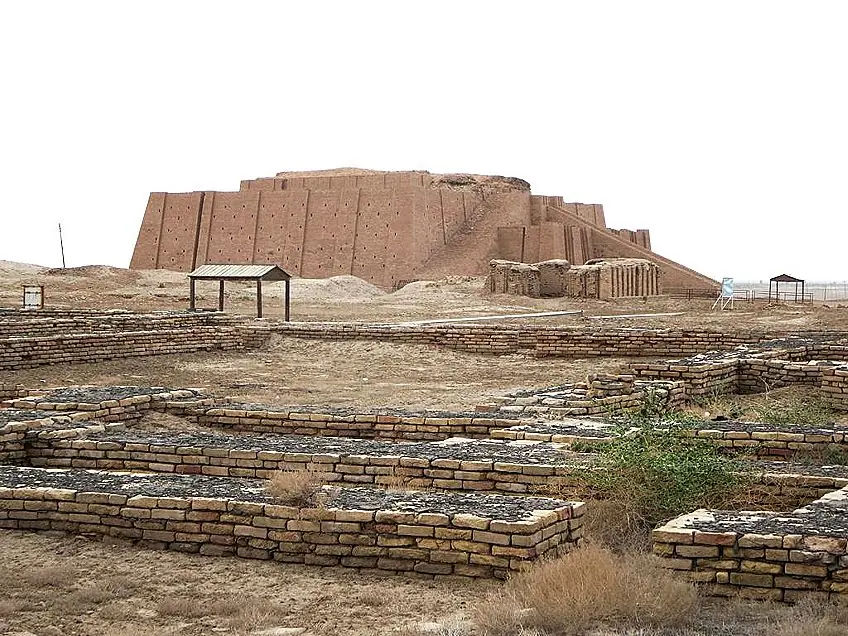 Remains of Ur City in Nasiriyah with the Ziggurat (2100 BCE); David Stanley, CC BY-SA 3.0, via Wikimedia Commons
Remains of Ur City in Nasiriyah with the Ziggurat (2100 BCE); David Stanley, CC BY-SA 3.0, via Wikimedia Commons
Rediscovery of the Ziggurat
While it is quite a pity that the cities containing the ziggurats were lost to the forces of nature, they would not remain buried forever. These structures and the cities that contained them would once again be rediscovered as the regions they inhabited became safe to transverse once more. This Ziggurat of Ur in particular was rediscovered in 1850 and uncovered in its entirety in the early 1920s. As we mentioned previously, this discovery and unearthing are attributed to the work of Sir. Leonard Woolley led an extensive excavation of the Ziggurat and uncovered it in its entirety before it was eventually opened to the rest of the world. What you might not know is that it was not only the Ziggurat of Ur that was uncovered at this location.
This makes sense considering that the ziggurat was positioned in the very center of the Ur, where many offerings and ceremonies would have been held for religious purposes.
This being said, there were many trinkets such as daggers, headdresses, and statues that were discovered in the area of the Ziggurat, many of which can still be found today! At the time the discovery was celebrated as never before had such an ancient structure or artifacts been uncovered, and further celebration ensued as they realized that they had only uncovered a fraction of the city and Ziggurat. Later discoveries uncovered various pieces of jewelry and plating found in graves located in and around the city limits.
Tourism of the Ziggurat
Considering the historical value and cultural importance of the Ziggurat of Ur, one would expect that tourism in the region would be quite profitable. However, according to a recent BBC report in 2021, tourism of the Ziggurat and the region as a whole seems to be sparse at best. According to the report, little more than four tourists at a time make their way to the historical site. This was quite disappointing, considering the efforts that the region undertook to encourage tourism. These measures included the implementation of a visa-on-arrival system which would allow one to secure their tourism visa after arrival in Iraq. It was not only the administration that undertook great lengths to ensure a positive experience for possible visitors from abroad though.
 Close-up View of the Ziggurat of Ur (2100 BCE); Kaufingdude, CC BY-SA 3.0, via Wikimedia Commons
Close-up View of the Ziggurat of Ur (2100 BCE); Kaufingdude, CC BY-SA 3.0, via Wikimedia Commons
Many tour guides took it upon themselves to learn English and even Japanese to further increase the comfort level and effective communication between themselves and possible patrons visiting the many sites the region has to offer. However, even though tourism is sparse, those that do visit the Ziggurat of Ur and other sites in the region have stated it is virtually impossible not to express pure awe in the wake of these structures. On a lighter note, whether it be due to a change in the political landscape of the region, its convenient tourism visa process, or a combination of the two, tourism has been steadily increasing, which is good not only for the tourism industry in the region but for the education of the public as to what is commonly referred to as the cradle of humankind.
Now that you know what a ziggurat is, what the Ziggurat of Ur is, where it is located, what it looks like, how it was built, what was used to construct it, and why it bears such great historical and cultural significance, it’s time for you to get out there and put your newfound knowledge to the test. If you’d like to visit the site, tours are readily available and provide even deeper insight into the culture and history of the ancient Sumerian people!
Frequently Asked Questions
What Were the Ziggurats Made Of?
Ziggurats found in both Iraq and Iran were made using a type of clay that had been formed to create huge clay bricks. These bricks weigh roughly 15 kg each and form the foundation of the structure, as well as some high portions.
Who Built the Ziggurat of Ur?
The Ziggurats were often commissioned by kings at the time as a show of strength and wealth. In the case of the Ziggurat of Ur, it was built by King Ur-Nammu, who belonged to the Third Dynasty of Ur around 2100 BCE.
Why Were Ziggurats Built?
Ziggurats were built as a show of power and wealth, but also in honor of the patron deity of each city-state. They additionally functioned as places of worship and ritualistic grounds. Besides conceptual applications, they had functional applications as assembly points for the public on major occasions.

I am deeply passionate about history and am constantly fascinated by the rich and complex stories of the past. As the editor-in-chief of learning-history.com, I have the opportunity to share this passion with a wide audience through the creation and distribution of engaging and informative content about historical events, persons, and cultures. Whether it’s through writing articles and blog posts or creating videos or podcasts, I strive to bring the past to life in a way that is both accurate and enjoyable. My expertise in history, combined with my strong writing and communication skills, allows me to effectively communicate complex historical concepts and make them accessible and interesting to a wide range of readers. I am truly grateful for the opportunity to share my love of history with others through my work on learning-history.com.

